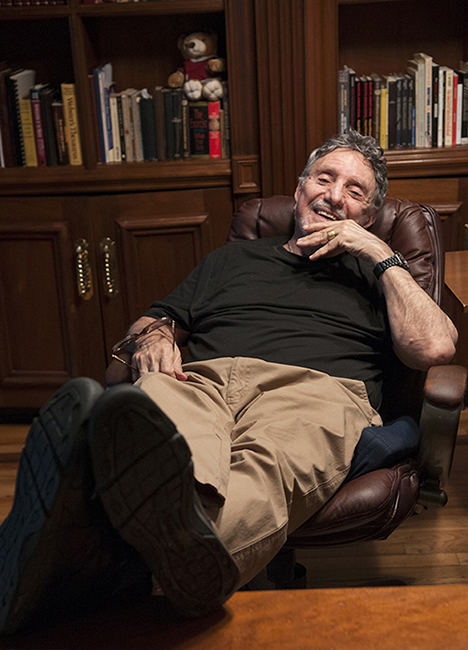Yesterday, author and director William Peter Blatty died. Most people will remember him as the guy who wrote The Exorcist. I’ll remember him as the guy who took the freedom he got from The Exorcist and wrote two complicated, thorny, hopeful horror novels and then adapted them into two complicated, thorny, hopeful horror movies (which he also directed). And I’ll remember him as a novelist who was capable of turning out dialogue that read as sharp and surprising as Elmore Leonard’s, only with a far more philosophical bent.
Born to Lebanese immigrants, Blatty was raised by a single mother whose poverty turned his childhood into a constant flight to stay one step ahead of eviction. Blatty received a deeply Catholic education and was a deeply devout Catholic. He was so religious that the needle that goaded him into writing The Exorcist was watching Rosemary’s Baby with its famously ambiguous ending that, to him, felt like a cop-out. How the hell could a horror movie end with the forces of evil triumphant? A few years later, he pitched a courtroom novel about a kid who kills an adult and uses a claim of demonic possession as her defense to Mark Jaffe of Bantam Books, a paperback company (Bantam would later sell the hardcover rights to Harper & Row). It was a New Year’s party, everyone was drinking, Jaffe bought the book. It wound up getting titled The Exorcist.
Written in a feverish 10 months, fueled by amphetamines, The Exorcist was a flop until a last minute guest slot on The Dick Cavett Show turned it into an overnight bestseller, moving 4 million copies before the film hit screens and turned it into a cultural touchstone (sales to date: 13 million). What’s often forgotten is just how essential Blatty was in making the movie what it became. It was sold out from under him in a sleazy, underhanded move by producer Paul Monash (Butch Cassidy and the Sundance Kid, Big Trouble in Little China) who offered Blatty $400,000 and points. Blatty smelled a rat and bluffed his way into Monash’s office, broke into his files while Monash’s secretary sat in the other room, and found a contract between Monash and Warner Bros selling them the book (which Monash didn’t yet own), and making massive changes (like cutting out all the priests). Blatty copied the memo and used it as leverage to make his own deal with Warner, one that gave him a producer credit and allowed him to write the script and protect it from harm; it also enabled him to insist that William Friedkin get the director’s chair instead of the studio’s choice, Mark Rydell (On Golden Pond).
The Exorcist was a major cultural moment, and it gave Blatty the financial and artistic freedom to do anything he wanted—and what he wanted was to write and direct religious movies. He did this by turning The Exorcist into a trilogy. I’ve written before about his novel The Ninth Configuration and the movie it spawned, also directed by Blatty. It’s a prequel to The Exorcist, focusing on the astronaut Regan predicts is “going to die up there” at her mother’s DC cocktail party. Both book and movie version of The Ninth Configuration are singular artistic visions, Catholic versions of Catch-22 with a Vonnegut chaser, and they’ve both developed cult followings and hold up today as hilariously absurdist acts of witness for a fallen humanity, capable of moving even the most areligious reader.
Even better is The Exorcist III. Based on Blatty’s book, Legion, it brings some of the characters from The Exorcist back, still living in the shadow of the tragedy that occurred in the original book. Legion is a serial killer novel that takes the tough cop, Kinderman, and the good priest, Father Dyer, both minor characters in The Exorcist, and sets them on the trail of a serial murderer called the Gemini Killer. Blatty based his Gemini Killer on the actual Zodiac Killer, who had written a letter claiming to be a fan of The Exorcist. It’s a book in which Blatty demonstrates just how good he is as a dialogue writer, turning in page after page of funny, philosophical, surprising, and sharp conversation that is the engine that moves the book forward.
Blatty wrote and directed the movie adaptation as The Exorcist III and as compromised as that movie is, thanks to studio interference, it still stands as one of the most artful, thrilling horror movies of the Nineties, and it’s still capable of giving an audience the screaming mimis during one of its scenes, in particular. Plus, Fabio appears as an angel.
So you can have The Exorcist. I’ll keep Legion and The Ninth Configuration and the movies they became. They may not have the massive heft of The Exorcist but they’re studded with small, miraculous moments that I wouldn’t trade for the world. At the end of Legion, Kinderman and Dyer have been raked over the coals. Their spirits have been sorely tested. Their faith in humanity is shaken. Kinderman sits in a hamburger joint rambling on about how mankind is Satan. He just got in a fight with the gruff, humorless counterman and as he rants eloquently, in the background of the scene, a homeless bum wanders into the restaurant. The counterman throws him out, but not before giving him a sack of burgers. It’s a simple act of human kindness that undermines all of Kinderman’s intellectual arguments. It’s a smart, small, touching moment. Blatty’s books are full of them.
Top image: Wikimedia Commons










